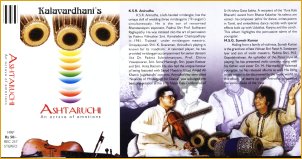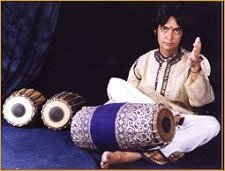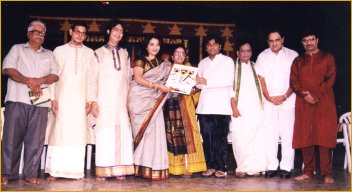
|
 |

|
 |
A DIFFERENT BEAT- K S R Aniruddha speaks to Lalitha Venkat about his debut album 'Ashtaruchi - An Octave of Emotions' Oct 2002 
Young mridangist K S R Aniruddha released his maiden album ASHTARUCHI - AN OCTAVE OF EMOTIONS, on October 20, 2002 at the YGP Auditorium in Chennai. Popular film music director A R Rehman released the audiocassette and CD and Y G Madhuvanthy received the first copy. 'Ashtaruchi, an octave of emotions' has concept and percussion by K S R Aniruddha, violin support by M S G Suresh Kumar and swarams by Vidwan Madurai N Krishnan. Disciple of mridangam maestro Umayalpuram Shivaraman, and son of dance guru Sudharani Raghupathy, Aniruddha is a left-handed mridangist who was initiated into the art of percussion by Kamaladevi Chattopadhyaya in 1981. Apart from playing for the productions of Shree Bharatalaya, Aniruddha has played accompaniment for prominent dancers like Padma Subrahmanyam, Chitra Visweswaran, Sonal Mansingh, Jayant Kastuar and Anita Ratnam. He has been featured in Jugalbandhi concerts with sarod maestro Ustad Amjad Ali Khan, an experience he cherishes greatly. Aniruddha is also a practicing lawyer. Aniruddha constantly experiments with different nuances of the mridangam and other percussion instruments. The Sri Krishna Gana Sabha, Chennai, adjudged his lec/dem 'Nuances of Mridangam for dance' the best presentation of Natya Kala Conference 2000. In recognition of his talents, Bharat Kalachar conferred the title of Yuva Kala Bharathi on him in 1998. He composes various 'jathis' for dance, writes poems in Tamil and derives special effects for dance with the udukkai, kanjira, many skin instruments and even conch. The percussive talent of this young musician is well brought out in this debut album. Aniruddha says he attempted to explore the shades of human emotions with three mridangams. The innovative idea seeks to communicate the flavours or rasas to elicit the melodic fragrance of each rasa, with the support of the violin. Tamil literature and the Natya Sastra speak of 'ensuvai' or eight emotions. The unique feature in this presentation is, that Aniruddha has played the 3 mridangams (Triangam) simultaneously to achieve the effect he wanted. Young violinist M S G Suresh Kumar, son of violin maestro M S Gopalakrishnan, has given the violin accompaniment. The renowned vocalist and composer, Vidwan Madurai N Krishnan, has composed the lilting musical phrases, in eight different ragas set to Chatusra Triputa talam. Recorded by Kalavardhani's, the cassette costs Rs.50 and the CD Rs.250 only -- a small price to pay for such inspiring music.  How long have you been working on this album? The request for this album came from the proprietor of Kalavardhani's Cassettes, Shri. Vijayakumar seven years before, but I could implement it only now, as I was busy with my B.L. Degree course. Hence, I productively applied my mind on this only about 4 months before the release. What inspired you to work on the theme of the rasas? Originally, Vijayakumar asked me for the NAVARASA-S, seeing me perform at various occasions. I too thought it fit to interpret the rasas through my mridangam. Being a dance accompanist, I thought it would be the most appropriate attempt on my side and a safer subject to confidently tread - familiarity gave the confidence. One can see the rasas when emoted by a dancer on stage. What means have you used to convey it through music? I always feel that the utmost of expression (bhava) does not create the 'rasa' without a pinch of music. After all the rasika isn't deaf, a 'poorna-rasa' should strike at the four senses, if not all. "It is sound that makes silence golden ". As a percussionist who plays only for dance, what is the message you wish to convey through Ashtaruchi? There have been, are and will be a million more albums with the mridangam as solo or group, to convey the intricacies of Laya, (Arithmetic) Tala, Rhythm, Beat etc...But I've used my theory and practice of dance mridangam and my percussive skill of wielding three mridangams simultaneously, to elicit the fragrance of the visual rasa-s in aural form, being a dance mridangist. According to me: " Rhythm is fragmented melody" Ashtaruchi seeks to communicate the inner emotions through the mridangam with the support of the violin. My message through Ashtaruchi is that - dance mridangam is equally complex, challenging and competitive and very similar to mridangam as a musical accompaniment. It requires special knowledge, skill and ability as in the case of any other fine art. It's a common belief that the mridangist has no big role to play in a Bharatanatyam recital as there is a 'nattuvanar' already setting the beat and the tempo. Your comments. Mridangam is an indispensable accompaniment for Bharatanatyam. Though the 'nattuvanar' plays the cymbals and also verbally expresses the 'sollu'-s, the mridangist synchronizes the dancer's movements to the jathi and correspondingly to the song as a thread in a garland. The work of the nattuvanar and the mridangist may seem somewhat similar but I would say that the mridangist's job is more complex. And I wish to add that a 'nattuvanar' cannot chirp like a parrot or roar like a lion in a forest scene (for example); this could be matched only by the mridangist of a certain level of experience. Mridangam playing for dance does not require expertise as everything is preset and practiced. Musicians only add to this notion when they turn up for very few rehearsals. Your views. Everything is preset in music itself. One cannot eliminate that a musician has not preset and practised a raga - alapana at home to a certain level. It so happens that new diversions are made spontaneously on stage from the inspiration drawn from the crowd/environment during a concert. For that matter, every note of the violinist and every beat of the mridangist are familiar to them in their respective cases. It is how creative and innovative an artiste is during the concert that ranks him high or low. Hence though the dance movement may be preset and rehearsed, what matters and explains their expertise is in the handling of the artiste. You are always experimenting with percussion rhythms using various skin instruments. Have you developed any such instrument or modified an existing one to create special effects for dance programs? My guru, Umayalpuram Sivaraman sir has made a trial of fibreglass mridangam. I believe the right learning, practice and performance of the art form itself is an invention from within. You recently composed special jathis for Anita Ratnam's latest solo Vaitharani that deals with the passage of the soul. What type of jathis have you evolved to complement your percussion rhythms in this and other productions? As a composer of jathis, I become the dancer instead of a mridangist, to balance the mood and rhythm of the creation. If it means a mridangist without in-depth knowledge in dance could compose, then every mridangist will be a composer no matter he plays for dance or not. Any special project lined up for this December season? Season programmes are themselves lined-up for this December, each and every one of which is a special project for me.  KSR Aniruddha 119, Luz Church Road Mylapore, Chennai 600004 Ph: (91 - 44) - 4994460 |